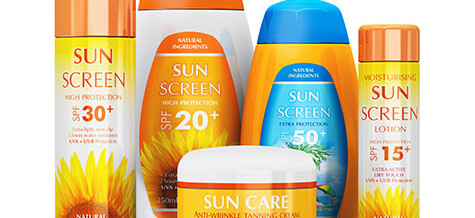
I am of the baby boomer generation that didn’t use sunscreen growing up. The “in” thing was slathering baby oil all over our bodies to enhance the tanning effects of the sun. I’ll spare you the details of my sun-spotted arms and hands, but I certainly wish I knew then what I know now!
When my kids came along, I thought I was being a diligent parent when it came to applying sunscreen. However, little did I know that those sunscreens, as well as many on the market today are full of toxic chemicals. And I was using them on myself as well.
Over the years we hear of UVA and UVB rays, waterproof, water-resistant, and when and how many times to apply sunscreens. The SPF numbers start at 15 and go up to 60. It can get very confusing. This is what I’ve learned over the years…
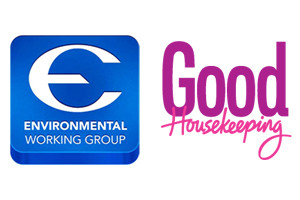
The Environmental Working Group, and The Good Housekeeping seal are good indicators of quality.
Most of us know that sunscreens protect us from skin damage and sunburns, but they also protect us from skin cancer. More than 3.5 million cases of basal and squamous cell skin cancer are diagnosed in this country each year. Skin cancer accounts for one half of all the cancer diagnoses each year. In 2013, the Environmental Working Group (EWG) reviewed 500 sunscreens specifically designed for sport and beach use. What they found was shocking, according to an article in Good Housekeeping:
- Around 60 percent of those 500 sunscreens contained oxybenzone, a potentially harmful hormone-disrupting compound, damaging cells and possibly leading to skin cancer.
- Around 75 percent of those sunscreens were found unsafe, ineffective or both.
- Sunscreens containing retinyl palmitate were possibly linked to increases in skin cancer.
- At the end of their review and testing, only 39 sunscreens made the “recommendation” cut out of 500.
Other Bad or Harmful Ingredients
-
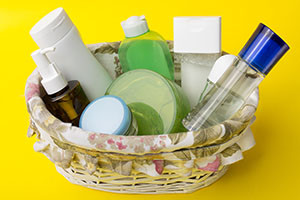
Highly toxic chemicals in many sunscreens include parabens, phthalates and polyethylene glycols.
Parabens – What is a paraben, and why should I care? Parabens are chemicals used as anti- microbial preservatives that extend the shelf life in food, pharmaceutical and cosmetic products. They are widely used. Parabens have been considered “highly toxic” by many, including the Organic Consumers Association. In the 1990s, parabens were deemed xenoestrogens—agents that mimic estrogen in the body. “Estrogen disruption” has been linked to breast cancer and reproductive issues. The European Commission on Endocrine Disruption lists parabens as a category 1 substance. And in 2004 British cancer researcher, Philippa Darbre, Ph.D., found parabens present in malignant breast tumors. (Read more in my November 4, 2014 post on “The Perils of Parabens.”)
- Phthalates – The National Institute of Health claims that they are a group of chemicals used to soften and increase the flexibility of plastic and vinyl. Polyvinyl chloride (PVC)is made softer and more flexible by the addition of phthalates. They are used in hundreds of consumer products, including sunscreens.
- Polyethylene glycols (PEGs) – Propylene Glycol is a form of mineral oil, an alcohol produced by fermentation of yeast and carbohydrates. Mention Propylene Glycol (PG) to most people in the science world and they will probably tell you that it is a toxin. It is used in everything from hydraulic and brake fluid to snack foods. The use of PEGs is somewhat controversial but when I read that though cancer might not be a concern, it was also found that PG provoked allergic reactions in patients with eczema and other skin allergies. Further studies done in in vitro tests on mammalian cells revealed that some cells underwent mutation. (Natural News) And we want to use this on our bodies? Not controversial for me.
- Synthetic Fragrances – Not as bad as the first three, but can cause allergic reactions for some people.
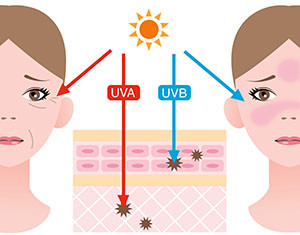
Both types cause damage to our skin.
UVA and UVB – What do they mean?
UVB – Ultra Violet B rays reach earth from the sun and penetrate the upper layers of our skin, causing our skin to burn.
UVA – Ultra Violet A rays penetrate deeper through the skin, causing visible signs of aging with wrinkles, sun spots and loss of elasticity. Note: UVA rays can even penetrate through windows.
Alert: Both UVB and UVA rays are linked to skin cancer along with eye damage, premature again and wrinkles according to the Skin Cancer Foundation.
Choosing an SPF Level in your sunscreen

Our skin, whether dark or light, needs protection from the sun’s damaging rays.
SPF stands for “Sun Protection Factor.” SPF only protects the skin from UVB rays (the upper layers), not UVA rays. No matter how often you reapply your sunscreen, it’s important to have the right one for you.
- SPF 15 lets you stay out 15 times longer filtering out approximately 93 percent of incoming UVB rays.
- SPF 30 lets you stay out 30 times longer filtering out approximately 97 percent of incoming UVB rays.
- SPF 50 keeps out 98 percent which may make a big difference if you’ve had a history of skin cancer or are light-skinned.
- Reapplying SPF 15 is not the same as starting out with SPF 30!
- A higher number SPF doesn’t necessarily mean better protection. The EWG recommends purchasing sunscreens with SPFs higher than 15 but no greater than 50. Don’t be tricked into the higher numbers. I usually use a 30 or 40 and that’s even when I’m sitting under a beach umbrella with regular application of two hours.
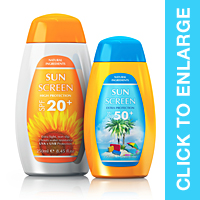
UVA + UVB = “Broad Spectrum” sunscreen. Be sure to check the label and choose a non-toxic formula when you can.
What does “Broad Spectrum” mean?
Bottles that say “broad spectrum,” indicate that their ingredients protect against both UVB and UVA rays.
The primary ingredients in natural sunscreens that provide broad spectrum protection are zinc oxide and titanium dioxide. Some folks don’t like the zinc as it leaves a whitish film on the skin but it’s really effective in protecting the skin. I’ve seen lifeguards wearing it on their noses at the pool and the beach my whole life. Now it’s just time to get it on our bodies. I’ve used these and they do work. Dermatologists highly recommend selecting a broad spectrum sunscreen, rather than simply focusing on the SPF number.
When to Apply?
Laura Schocker at the Huffington Post claims that the “first sunscreen mistake is not wearing any. “ For the past few years we keep hearing that one should wear sunscreen everyday before going outside, even when it’s not sunny. It’s recommended that we apply it 30 minutes before going outside to allow it to penetrate our skin. I put mine on after my moisturizer and before a little foundation.
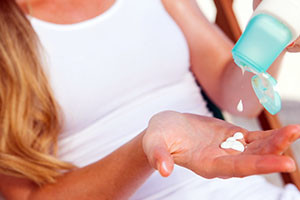
Re-application is key in protecting our skin from damaging UVA and UVB rays.
How Often To Re-Apply Sunscreen?
According to the Australian Academy of Science:
- Reapplication of sunscreen should happen at least every two hours or every hour if you are sweating a lot.
- If you notice your skin turning pink, don’t wait! Reapply right away.
Waterproof VS. Water Resistant?
Studies show no sunscreen is truly waterproof. According to the FDA, water resistant sunscreen must continue to work at the same level for up to 40 minutes in the water.
Who Should Wear Sunscreen?
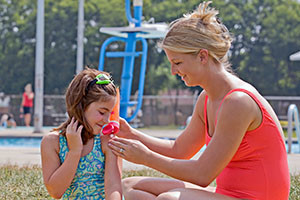
Because children are caught up in play, it is up to us to manage reapplying.
All of us, of course! But please note the following:
Under Six Months – The Skin Cancer Foundation recommends that children under the age of six months should not be exposed to the sun as their skin is highly sensitive and the chemical ingredients in many sunscreens are very unhealthy to them. Shade and protective clothing are essential to protecting these infants.
Six Months and Up – Anyone over the age of six months should use sunscreen daily, especially those who work inside near windows which filter out UVB but not UVA rays.
Reapply! Children are at higher risk because they forget to reapply. It’s very important that adults take the lead and manage this. Water enhances the effects of sun exposure and it’s reported that those who vacation often at the beach have had a 5% increase in skin moles-a major risk factor in malignant melanoma.
Sprays – Spray sunscreens are popular, especially for use on children. But the safety experts, especially the EWG, are particularly concerned about the possibility that people might accidentally breathe in the ingredients, a risk that’s greatest in children, who—as any parent knows—are more likely to squirm around when they’re being sprayed. Please save the spraying for adults! It’s always safest to
spray on your hands first, then rub it in. I know my husband likes the sprays, especially as the lotions are messy on his hairy legs.

Sunscreen is critical at the beach, pool and park, every day, all year long. Especially during the summer! Even when it is cloudy, it is good to get in the habit!
What are my Healthy Sunscreen Options?
Lucky for us there are more and more non-toxic sunscreens that are lining the shelves from Target to Whole Foods to online companies.
Here are my three tried and tested sunscreens over the past several years. I’ve used them with success on both the adults and children in our lives.
- California Baby – Hypoallergenic, fragrance-free, water-resistant and chemical free using oly organic and sustainably grown ingredients. Won’t stain skin and isn’t greasy. $20 – $40, found in Target and other local grocery chains. www.californiababy.com
- La Roche-Posay Anthelios Face Cream in SPF 40 – Fragrance-free, and protects against both UVA and UVB rays. It’s ingredient, Mexoryl SX is a sun filter specifically approved by the FDA for protection against short UVA rays. Used in Europe since 1993 and FDA approved in the US in 2006. Offering photo-stable protection, Anthelios won’t lose effectiveness in the sun. $22 but totally worth it! Available at Target, Amazon or www.laroche-posay.us
- Kiss My Face Kids Mineral Sunblock Lotion – free of chemical ingredients and not greasy. $14 and found at Target, Amazon and at www.kissmyface.com
- Image Skincare – I have used the sunscreen for the face everyday for years. My husband likes the spray bottle for convenience. Lots of good offerings with them at www.imageskincare.com and at Amazon. I also use their lip treatment before I go to bed at night. Good stuff!
- Alba – Part of Jessica Alba’s skincare line: www.albabotanica.com. A wonderful range of products.
Other Recommended Healthy Options:
There are more and more healthy options appearing each day. Check out these product sites: And several of them are REEF FRIENDLY! Badger Suncreens are my favorite and their choices for Children really work! I can attest!
- Eco Formula SPF 30+ by Raw Elements-*SafeMama Award Winner Best Ingredients 2013 www.goodthingsgreenthings.com
- Badger All Natural Sunscreens-SafeMama Award Winner 2013-Best Overall Sunscreens. www.BadgerBalm.com
- Mustela Broad Spectrum Mineral Sun Stick www.mustelausa.com
The Environmental Working Group is also a great resource for vetting safe, non toxic products of all sorts with ratings!
- Environmental Working Group: www.ewg.org
Miscellaneous Information about Sunscreens
- Some beauty manufacturers are now selling moisturizers with built in sunscreens but I’ve read that it’s best to separate the two as the sunscreen percentage doesn’t really offer an effective amount of protection.
- Expired sunscreens literally fall apart offering no protection after a season (HuffingtonPost).
- There are now tinted mineralized sunscreens with zinc oxide and titanium that you can match to your skin alleviating the whitish film from the zinc oxide.
How to Naturally Treat a Sunburn
And just in case you do end up with a burn: Apply apple cider vinegar to the area which will take away the stinging. Then apply coconut oil to remove the vinegar smell and soothe the skin.

Enjoy the sun, with proper protection all around!
With all of the sunscreens out there, it’s easier than ever to find non toxic options. After doing my research, it makes sense to seek out the “Broad Spectrum” sunscreens that provide both UVB and UVA protection. Let’s all enjoy the Vitamin D that sunshine brings us this spring and summer. Let’s also all commit to remember our daily applications and to protect our children from the damaging effects of the sun.
Welcome the Sunshine and Be Healthy!
Sources:
Consumer Reports (July 2014)
Environmental Working Group
Good Housekeeping
Huffington Post (June 2013)
Laura Lanes Skin Care
LiveStrong
LovetoKnow (Beth S. M.D.)
National Institute of Health
Natural News
Organic Authority
PopSugar
Prevention-(April 30, 2012)
SafeMama
Skin Cancer Foundation
If you “Like” this post, I’d be thrilled if you’d share it.
APR
